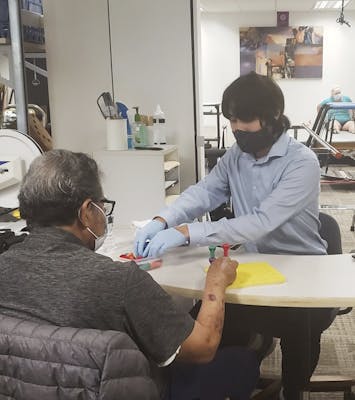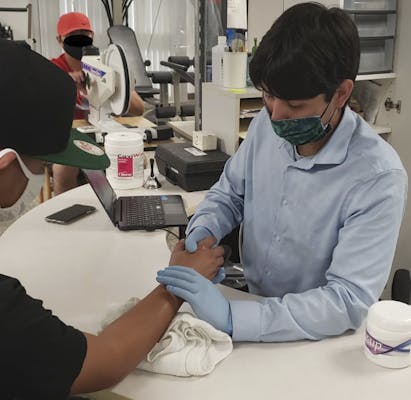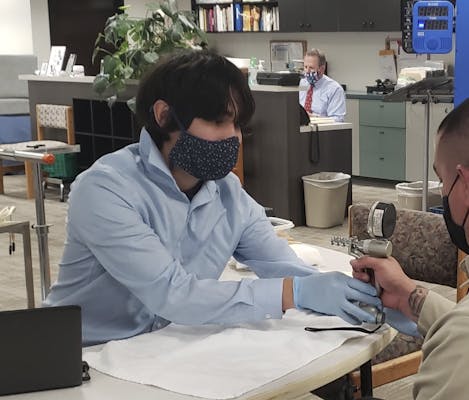Hands and wrists are complex parts of the body made up of bones, tendons, muscles, nerves, veins, ligaments and connective tissues. They make it possible to perform movements, and provide the dexterity and strength needed to carry out everyday tasks at home and at work. We often take the ability of our hands for granted, unless they are limited by pain or injury.
We use our hands for almost everything we do from morning until night. Because of their constant use, hands and wrists are often injured. Any direct trauma or laceration to the hand can result in serious consequences if one or more tissues are damaged. An injury to the area will therefore affect a person’s ability to do simple and complex tasks. Ensuring appropriate diagnosis, assessment and rehabilitation for injuries to hands and wrists is essential to preventing long-term adverse effects and possible disability.
Hand therapy is a type of rehabilitation provided by an occupational therapist for patients suffering from a condition affecting their hands and upper limbs.
How an Occupational Therapist Can Help
Occupational therapists have a high degree of specialization that requires continuing education and, often, advanced certification. This enables the hand therapist to work with patients to hasten their return to a productive lifestyle.
Hand therapy is the science of treating strength and range of motion in an individual’s upper extremity. It includes arms, hands, wrists, shoulders, elbows, and forearms. Patients seeking hand therapy generally have an injury or chronic condition which demands therapeutic assistance.
Hand and wrist therapists that specialize in this treatment, provide preventative care, post-operational rehabilitation, and non-operative therapy. If you are looking to regain functionality in some part of your upper extremity, then hand therapy may be right for you.
In some instances, a specialized tool called Instrument Assisted Soft Tissue Mobilization (IASTM) is used to effectively breaks down scar tissue and reduce inflammation that causes pain and restricted mobility. This stainless steel instruments combs over and "catches" on fibrotic tissue, which immediately identifies areas of restriction. The instruments enable clinicians to treat soft tissue lesions with the depth, pressure and specificity necessary to affect the condition at the site of the pain, as well as following the kinetic chain to find and treat the cause. Once the tissue dysfunction has been identified, the instruments break up the scar tissue so it can be absorbed by the body.
Conditions Treated
Hand therapy can be used to treat many common conditions. It aims to lessen pain and help patients reclaim average mobility and functionality. It can improve:- Carpal Tunnel Syndrome: hand or arm – tingling or numbness caused by a pinched nerve
- Cubital Tunnel Syndrome: hand or arm – severe pain, tingling, muscle weakness, or numbness caused by a pinched nerve
- Ganglion Cyst: hand or wrist – benign lump on the joints or tendons (unknown cause)
- Tennis Elbow: outer elbow, forearm, or wrist – pain, tenderness, or swelling caused by a repetitive arm motion
- Hand Pain: hand – pain with moving fingers or turning the wrist (many causes)
- Repetitive Motion Disorder: any part of the upper extremity – joint stiffness, tingling, tenderness, or muscle weakness caused by overuse or repetitive motion
- Trigger Finger: finger – clicking, popping, stiffness, or tenderness caused by an inflamed tendon that makes the finger get stuck in a bent position
- Golfer’s Elbow: hand, fingers, wrist, or elbow – tingling, tenderness, or stiffness caused by repetitive, forceful stress to an area
- De Quervain’s Tenosynovitis: wrist – tenderness, pain, or swelling caused by repetitive motions
- Dupuytren’s Contracture: ring and pinky finger – bent finger or lump located in the palm, caused by tissue tightening and thickening in the hand
- Sprains, Dislocations, and Fractures: any part of the upper extremity – pain, swelling, or tenderness caused by trauma to the body
- Burns and Wounds: any part of the upper extremity – blistering, pain, peeling, or redness caused by damage to the skin or tissue
- Amputations: any part of the upper extremity – removal of a limb or appendage caused by injury, illness, or disease
- Fine Motor Skill Deficiencies: hands or fingers – coordination problems or muscle weakness caused by dyspraxia, strokes, and other disorders
- Arthritis: any part of the upper extremity – intermittent or sharp pain, swelling, stiffness, or decreased range of motion caused by infections, normal wear and tear, and some diseases
Stroke Patients
Specialized care is available for stroke patients needing improvement with upper extremity movement and strength to help them return to activities of daily living. Through our comprehensive neuro rehabilitation program, we can assist patients with individualized programs designed to increase balance, movement and reaction time, memory, and cognitive function.
Using our state-of-the-art SMARTfit system that employs dual-tasking that combines cognitive and motor function training we can create individualized programs that are highly-engaging designed to wake up the brain and spark the development of new neurons and physical skills in order to increase performance in functional activities.
What can I expect during a therapy appointment?
Your therapist will want to make sure that you are progressing every session towards your goals. To do this, the therapist will measure your range of motion, strength, posture, or nerve sensation during every visit – depending upon your needs. Your therapist will also discuss exercises that you can complete at home to further your rehabilitation. These activities will help your recovery advance quicker than just therapy appointments alone.
Hand therapy exists to lessen pain, not make it worse. That being said, sometimes working muscles will cause soreness after treatment is over. Stretching may also be uncomfortable, but any tenderness usually dissipates within a day. Your hand therapist is there to make sure you are comfortable during your session; pushing your body too far can worsen injuries.
If you believe that you are a candidate for hand therapy or assistance with improvement from a stroke or other neurological condition, contact us to schedule an evaluation. You don’t have to live with pain or loss or motion for the rest of your life. Our occupational therapist can ease a multitude of symptoms and get you back to where you want to be.




